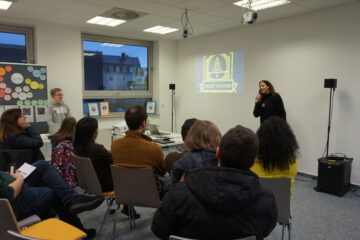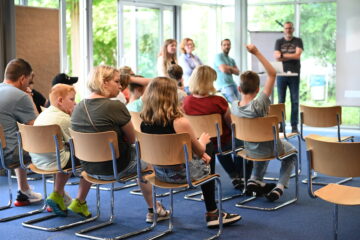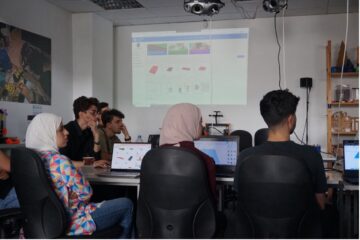For the first time, we held a two-part workshop at the Fab Lab, where young people learnt the basics of the components that are used in a computer. Besides a few short theoretical parts, the main focus was on practice: we wanted to enable the participants to apply what they have learnt in practice.
As you might remember: with the support of SIEGENIA, we were able to transport four pallets full of computers that were donated to us. These made it possible for each participant to work on their own PC and even take it home with them at the end – free of charge!
In the first part of the workshop, we started from scratch – no previous experience needed. We clarified questions such as “What is a computer?” and “How does it work?”. To summarise briefly: A computer is an information processing machine that receives, processes and outputs data from users.
We then explained the individual components of a computer to the participants and showed them where they can be found inside the computer. The importance of thermal paste was also discussed in this section of the workshop, which helps to cool the main processor (CPU) so that the computer does not overheat.
The third and final theoretical part dealt with how a computer can be kept clean to prevent “dust bunnies” and ensure air flow. If you clean your computer regularly, you can save time and money, as it will last longer! Therefore, the individual parts must be cleaned carefully. They should be removed one by one and cleaned with cotton buds and isopropanol, never with water!
With all this knowledge, we then moved on to the practical part. The participants were now able to start disassembling their computers part by part, first SSD, then RAM, then the CPU fan and finally the CPU itself. A handout explaining the individual steps enabled the participants to work independently.


Individual parts, including the fan and the CPU, were then cleaned before the participants could begin to reassemble the computer. This also involved using the thermal paste, which was applied to the CPU in the shape of an ‘X’.
After that, the participants learnt about operating systems and installed one on their own computer. It manages applications and combines hardware and software. It is there to manage files, memory and running processes and provides the user interface.
Finally, it was important for us to inform the participants about possible dangers on the internet so that they are well prepared to use the computer after the workshop. Among other things, we took a closer look at data and browser security, phishing as well as scams. Therefore, we used case studies to illustrate these topics in a realistic way for the participants.
We had a lot of fun organising this workshop and are happy that we are able to offer such a workshop. The Computer-Workshop will continue to take place in the future. If you are interested in participating or supporting as a volunteer, you are welcome to contact Jonas Kosiahn via email (). Maybe we’ll see each other at the next one!
















0 Comments